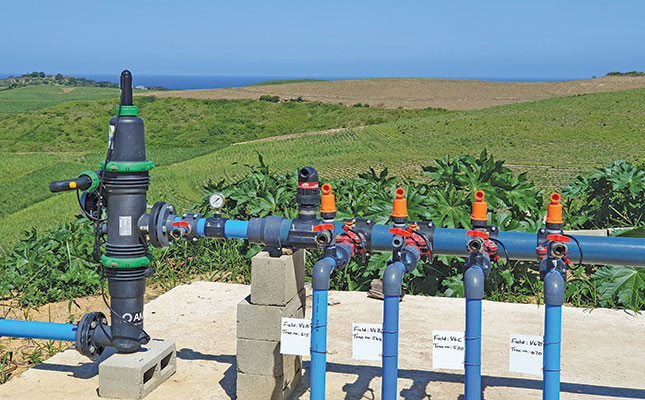[ad_1]
Maximising water-use effectivity in South African undercover crop farming operations has grow to be each a monetary and ethical crucial. But choosing essentially the most acceptable undercover irrigation applied sciences generally is a problem in itself. Three native specialists shared their recommendation on this more and more advanced subject with Lloyd Phillips.
Photo: Netafim South Africa
A fast take a look at ‘irrigation systems’ on the Internet reveals a bewildering array of choices. They embody the older applied sciences, the most recent ones, and others beneath improvement that promise to be much more superior than their predecessors or rivals.
Chris Barnard, a farmer and part-time agronomist at irrigation applied sciences manufacturing firm Agriplas, cautions that earlier than an undercover cropping operation invests in a brand new irrigation system or upgrades its present system, its house owners ought to rigorously contemplate what the enterprise hopes to realize.
“With the focus being on the latest technologies for cultivating undercover crops, the basic principles for ensuring the long-term sustainability of an undercover operation are often forgotten. Hands-on management should never be substituted by automated equipment.”
The progress medium
Barnard says that efforts to maximise water-use effectivity will fail from the beginning if the irrigation system will not be acceptable for the rising medium or substrate, resembling peat moss, bark or perlite.
This is very so provided that undercover crop manufacturing is very intensive and makes use of small plant containers or baggage.
Each container and its rising medium has restricted water-holding capability; usually, the smaller the container, the extra typically the water within the medium must be replenished.
To forestall over- or under-irrigation, the frequency and quantity of every irrigation have to be adjusted for the crop kind, the scale of the containers, and the traits of the rising medium.

“Irrigation water must be applied in such a way as to create a balance between the water and oxygen in the substrate. This will ensure that the plant’s oxygen-absorbing and feeder roots can develop in specific areas within the substrate,” says Barnard.
To decide whether or not or not the undercover crop is being over-irrigated, the grower ought to measure the quantity of water that runs out the underside of a plant container or bag and evaluate it with the quantity of irrigation water utilized.
Excessive run-off might point out that an excessive amount of water is being utilized and the plant’s roots are susceptible to turning into waterlogged.
However, the diploma of run-off might not be telling the entire story. Barnard factors out that the standard and water-holding traits of a rising medium deteriorate over time.
This may end up in compaction of the medium, resulting in much less water run-off and waterlogging of the rising medium and roots.
If, on this case, the farmer or supervisor calculates the irrigation necessities just by monitoring water run-off from a container, she or he might find yourself over-irrigating the crops.
“The producer must regularly inspect some of the bags or containers by opening them to assess the water content and level of deterioration of the growing substrate,” explains Barnard.
“In undercover cropping operations where automated measuring of electrical conductivity within the growing substrate is not available, the producer should closely examine the different depths within a plant bag or container. This proactive approach will ensure a sound knowledge of the water and nutrient status of the substrate, especially before the crop’s important phenological [physical] growth stages.”
Plan to your complete system
Willem Botha, advertising supervisor of irrigation options firm Netafim South Africa, says the applied sciences accessible for undercover crop manufacturing are already extremely superior and can grow to be more and more extra so.
The range of this gear, used for irrigation, nutrigation, local weather management and infrastructure, may cause technical and effectivity issues for a cropping operation if every system is put in independently of the others.
“Planning is very important to achieve a successful undercover farming project and it’s equally important that this planning be done holistically. Irrigation planning is only one part of the bigger picture. It’s essential to get the experts involved in all the systems to sit around the same table to ensure that the different technologies can accommodate one another and work in sync to achieve high-precision undercover crop production.”
Botha cites the hypothetical instance of planning a whole irrigation system all the way down to the best element and putting in it, solely to search out it can’t deal with the fertilisation programme proposed by the crop nutritionists.
In this case, each the irrigation and fertilisation applied sciences will fail.
He provides that the principle requirement is for gear that ensures exact irrigation on the root zone of the crops, and applies an actual quantity of vitamins to the crops.
“A crop grown in a soilless medium requires correct, pulsed irrigation with constant water amount and nutrient content material, delivered uniformly all through the greenhouse.
“Undercover irrigation is applied using drippers, overhead micro-sprinklers, or overhead misting. An example of such equipment is arrow drippers, connected by micro-tubes to online drippers to ensure that water is delivered directly to a plant’s root zone.”
Other applied sciences he believes are essential for irrigating, feeding and defending undercover crops are high-end dosing systems able to making certain exact nutrigation, and micro-emitters for controlling the inside local weather effectively and decreasing the specter of frost.
Automated irrigation
According to Deon van Rooyen, gross sales supervisor at undercover rising options firm Vegtech, key components to contemplate earlier than selecting irrigation and different applied sciences are the water, substrate and electrical energy necessities; the wants of the actual crops; and the influence of weather conditions on the functioning of those applied sciences and the productiveness of the crops.
“The more that you have to change the ambient climate to suit a plant’s needs, the more expensive your greenhouse system becomes. It, therefore, makes sense to grow crops in areas where minimal changes are needed to the ambient climate to meet the plants’ requirements.”
Van Rooyen says that in more and more superior undercover crop manufacturing operations, the place technological automation is turning into ever larger, fit-for-purpose computerised controllers are important.
In his view, the capabilities of present greenhouse controllers lag behind the advanced applied sciences they’re meant to combine and function.
And whereas a mid-range controller could also be appropriate for managing, say, an undercover blueberry-growing operation, refined controllers are required to handle the manufacturing of crops resembling medicinal hashish.
“One of the most important aspects of good irrigation controllers is the planning and back-up support service offered by the company that manufactures or sells these products,” says Van Rooyen.
Email Chris Barnard at [email protected], or go to agriplas.co.za;
Email Willem Botha at [email protected], or go to netafim.co.za;
Email Deon van Rooyen at [email protected], or go to vegtech.co.za.
[ad_2]
Source link










